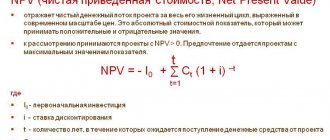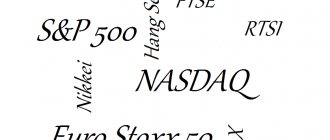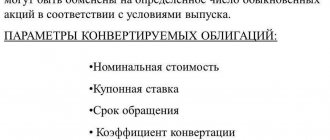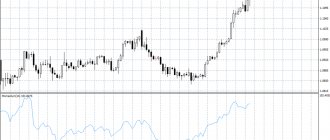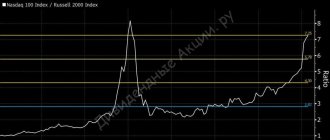- The simplest example of carry trade
- Rollover in the foreign exchange market
- Kerry trade: an example from life
- Profitable carry trade
- Unprofitable carry trade
- Low and high levels of risk aversion
- How to choose a currency pair for a carry trade
- Examples
- Risks in carry trade
- Let's sum it up
From time to time the mysterious “carry trade” is written about in economic news in this vein: they say, the ruble has fallen? Once again these nasty carry traders have ruined all our raspberries. No, to describe it in simple terms, is it really that difficult?
Not difficult. Indeed, carry trade operations have a powerful impact on the foreign exchange market of many countries.
What kind of carry is this? This is the curry sauce of borrowing or selling a financial instrument with a low interest rate and then using it to buy an instrument with a high interest rate.
By paying low interest on an instrument sold or borrowed, you, at the same time, collect high interest on the instrument purchased. It is clear that your profit will be the difference in percentage.
What is a carry trade
If translated quite literally, carry trade means “transfer of trade.” That is, in simple terms, moving it from a less advantageous place to a more advantageous one. Let me explain with an example.
Having arrived in the USA, you can borrow money from the bank at a ridiculous 2-3% - they are very cheap there compared to our country. And the Russian refinancing rate is 7.5%. Therefore, our banks can afford to offer deposits at 6-7% per annum. So, feel free to exchange the borrowed dollars for rubles and put it in the bank. And if not in a bank, then in federal loan bonds, or Eurobonds, where you can generally earn up to 8%. The difference of 4-5% will go to you.
Peak of popularity
The strategy dates back to the 80s of the last century, when it began to be used by large investors in the United States. Today, the carry trade has gained immense popularity. Although its main area of application remains the Forex currency market, carry traders also work in other areas.
Among the reasons for the popularity of “Carrillism” are the following:
- The strategy is considered low-risk.
- Has an acceptable profitability.
However, as always, there are pitfalls.
What did popularity lead to?
Now only the lazy don’t know about this strategy. Naturally, almost everyone tries to work with her too. The price to pay for the popularity was the excessively strong influence of carry traders on popular currencies. Their rate may fluctuate greatly due to the massive movement of money from investors choosing the optimal carry trade option.
A rate cut weakens the currency.
In fact, lower interest rates weaken the currency in two ways:
- Increases the volume of credit in circulation , which is an inflationary factor.
- Makes the financial return of bonds fixed.
When a currency depreciates, the balance of trade improves because a country's exports become relatively cheaper and its imports become more expensive. Additionally, currency devaluation reduces the overall debt burden because the total amount of debt is worth much less (as well as fewer payments due to the lower interest rate).
How the carry trade strategy works
Since the most important thing in a carry trade is the difference in rates, this is a long-term strategy. It is not suitable for intraday traders and scalpers.
Initial conditions
The first step is to find a betting difference that suits you. As a rule, carry trades are played on different currencies, so investors compare rates from central banks of different countries to choose the optimal pair. It is clear that the optimal rate is the lowest rate of the funding currency (source of funds) and the highest rate of the investment currency (investments).
In addition to the difference in rates, you need to carefully study the history of the selected currencies. They should be popular and have good predictable movement. If the price dynamics are chaotic, there can be no talk of any carry trade.
Today the most popular currencies for this strategy are:
- British pound/Swiss franc.
- New Zealand dollar/Japanese yen.
- Australian dollar/Japanese yen.
“Japanese” appears most often within this strategy, because the Japanese central bank has maintained negative rates for several decades in a row. And this is the most profitable option for funding currency.
However, over time, the situation may well change, and other assets will come to the fore. Therefore, it is very important for a carry trader to follow the news in this area.
What happens if the asset grows
This will be great, since the calculated potential income will be supplemented by an additional one in the form of a higher exchange rate difference. I think this is the dream of any carry trader - to enter an asset at the bottom and exit at the peak.
What happens when you fall
Not the best scenario for an investor working on this strategy. The main thing here is to guess how deep the drawdown will be and whether it will eat up the expected income from the asset. It is also important to determine whether a downtrend has begun and is turning into a long-term movement, or whether it is a correction and the price will return to a bullish trend.
Internal trading mechanisms
This mainly applies to Forex. The point is to extract the maximum difference from the swap. Let me remind you that the swap is charged by the broker when the position is transferred overnight. It can be positive and negative. The goal is to find currency pairs with a positive swap.
All central banks set key rates for their currencies. If the rate is high, then the currency is called high-yielding, otherwise - low-yielding. So, the goal of carry trading on Forex is to buy a high-yielding currency for a low-yielding one. At the same time, price movement is considered only as an addition to this earnings.
Earnings on a positive swap are called rollover.
Mechanics of income interest
The main principle of the carry trade is that interest should earn itself. Thus, it is first worth calculating how profitable the selected currency pair is. Traders usually use the following formula to calculate:
We will receive income per day, which we will focus on when building a strategy.
On the stock market
In principle, the meaning of carry trading is the same everywhere. Only in the stock market, they usually combine investing in some low-risk asset with playing on interest differences. OFZs or bonds of very stable companies are often used.
In the conditions of the foreign exchange market
Here you will not be able to get a double benefit, so you will only have to play on the difference in rates. However, traders make good income from trading futures on popular currencies.
On Forex
In Forex, kerrillism is used with all its might. The strategy is not suitable for intraday trading and scalping. Those who work with large volumes and over the long term can try the carry trade. Read more about how to use it below.
Rollover in the foreign exchange market
As you know, currency pairs are traded on the Forex market. If you click “buy” for EUR/USD, an operation is carried out that is equivalent to buying euros and at the same time selling dollars, for which these euros are purchased. At the same time, you essentially pay interest on the sold currency position, collecting it on the purchased currency position.
The good thing about carry trading on the spot market is that these interest payments are made daily based on the open position. What kind of interest? In the foreign exchange spot market, all trades are technically closed at the end of the day. Many people in retail Forex don’t even realize this when they hold a position open for several days.
In fact, Forex brokers constantly close and reopen currency positions (this happens automatically and unnoticed by the trader), after which they calculate the debit/credit, taking into account the difference in the discount rates of the two currencies overnight (“overnight”). As a result, this price must be paid to roll-over the position to the next day.
In other words, rollover in forex is the interest paid (or earned) for rolling over an open spot currency position overnight. Moreover, each currency has an overnight interbank discount rate , so two currencies equal two discount rates. If the discount rate on the purchased currency is greater than the discount rate on the currency sold, the rollover will be positive and you will earn money from it. If everything is the other way around, you will have to pay the rollover.
swap at your forex broker . Many brokers have a calculator where the swap is always indicated, like Alpari:
Now is it clear why this operation is called “carry”? In English, carry can be translated as “carrying.” There is also roll over, which translates as “extension”. The entire operation is based precisely on the interest rates of the two currencies and the cost of transferring them for overnight positions.
The best thing about the foreign exchange market, why the carry trade has become so popular, is the large leverage. Forex, as you know, is margin trading. In other words, you need very little money for the broker to open a position that is many times greater than your capabilities. Many brokers only require 1% or 2% of the total amount, this is the fantastic leverage they provide.
Kerry trade: an example from life
Let's look at how this works. Alexey from Khabarovsk moved to New York for permanent residence and decided to earn extra money, since he had made $10,000 selling caviar to aborigines and the money was burning his pocket.
Instead of spending it on cognac and depraved American old women, Alexey decided to increase this capital. He goes to the bank and is determined to deposit funds. Where the manager says to him: “Dear Lesha, it’s so good that you came to us. After all, we pay 1% per annum on dollar deposits, isn’t that cool?” (Western banks have extremely low interest rates on deposits).
Alexey reflects: “So with 10,000 dollars I will receive... 100 dollars in a year? Have you all gone crazy here?” Not serious, to be sure. He studies where he can make more money and refuses such an “attractive” deposit.
Alexey has already tried trading in Forex on a demo account and knows what a carry trade is, so he simply opens an account with a real Forex broker for $10,000.
Now he finds a currency pair whose interest rates differ by +5% per year. And he buys as much as $100,000 worth of this currency (thanks, leverage). The broker only requires 1% of this amount for a leverage of 1:100, so Alexey only required a margin of $1,000. So, Lesha now has literally $100,000, which brings him 5% per year.
Alexey does nothing else: drinks beer for a whole year and plays Civilization. What will happen to him next? Three options:
- The currency position will lose value. Alexey bought for an increase, but the price fell, which means he loses everything except the margin that the broker held. All he has left is $1,000 in his account.
- The currency pair ends the year with the same discount rate, and the exchange rate remained at approximately the same level. Alexey lost nothing and received 5% on his $100,000 position, which is $5,000 for his original $10,000. Not bad, the income was 50% for the year.
- The currency pair has increased in price. Here Alexey was incredibly lucky, since he not only took back his $5,000 for the carry trade, but also made money on changes in exchange rates. The Bentley of his dreams becomes a reality.
Thanks to the leverage of 1:100, Alexey can continue to earn 50% per year, however... This same shoulder could cause him to lose everything.
Here is an example of a currency pair with a differential discount rate of 4.40% as of September 2010.
If you buy AUD/JPY and keep this position open for a whole year, the positive carry will be +4.40%.
If he had sold AUD/JPY, it would have cost him minus 4.40% of his negative carry.
As you can see, this is not a difficult concept at all, once you sober up a little and think about it carefully.
Profitable carry trade
The carry trade was considered a very profitable, but also quite risky strategy. An investor must be confident that buying a high-interest currency and selling a low-interest currency will work. The economic situation in the country may not be the best, but he hopes that everything will work out. It all comes down to the key rate.
If the economy is performing well, the Central Bank may well raise the key rate to control inflation. This is just a gift for the carry trader, since this way the percentage earned will increase even more.
Unprofitable carry trade
If the country’s economic prospects are so-so, buying its currency is unlikely to be a good idea, because the Central Bank can at any time lower key rates in order to properly “kick” its economy. The carry trade works best when the investor has a risk appetite and is willing to take on some trading risk.
A carry trade ends badly when the level of risk aversion is too high, say when selling a currency with a high interest rate and buying one with a low interest rate. It all comes down to risk and the desire to work with it.
In recent years, central banks of various countries have taken steps to stabilize financial markets and increase liquidity. As a result, interbank overnight rates dropped significantly, and it became cheaper for banks to lend money to each other. As a result, situations often arise when the rollover for the sale and purchase of currency will be negative, because banks regularly change the spreads on these instruments. But as soon as rates rise, it’s time for carry traders.
Low and high levels of risk aversion
Let's assume that the economic situation in the country is so-so, the situation leaves much to be desired, there is a crisis. What then do ordinary citizens do? As a rule, they find, if not highly profitable, but reliable investments. It doesn’t matter that the interest rates are low, the main thing is that it’s a sure thing.
Quite reasonable, since this way a good backup plan is built in case of really bad situations, say, if you lose your job. In investment terms, these citizens have a high level of risk aversion. Well, they don’t want to take risks, they don’t want to, that’s all.
The psychology of large investors is not so different, because they are ordinary people with their own fears and desires. When a country has a bad economic situation, investors prefer to invest in safe currencies with low interest rates, such as the US dollar or the Japanese yen.
And this position is exactly the opposite of the carry trade , because the influx of capital into safe assets leads to investors choosing currencies with low interest rates.
How much can you earn
Nothing can be known for sure here. Still, this is not a bank deposit in native currency at a fixed interest rate. In order to estimate your expected income, you need to consider the following factors:
- Difference in rates of funding and investment currencies.
- The prevailing trend of currency movements.
- Selecting suitable assets in the investment currency and the level of income on them.
Typically, the investor's net income from this strategy does not exceed 5-8% per annum.
How to become a trader - step-by-step guide
- Step 1: first you need to understand who a trader is and what he does.
- Step 2 : Analyze the markets and venues you would like to trade and then start learning different trading strategies.
- Step 3: practice using a demo account, it will allow you to roughly understand how the market works and what kind of income you should expect.
- Step 4: Understand the role psychology plays in trading.
- Step 5: open a real account and start trading.
- Step 6: Develop and improve your own strategy.
Benefits and Risks
It is naive to believe that this strategy is popular because it does not carry any risks. This method of trading also has both advantages and disadvantages. Let's look at it below.
What benefits can you get?
The main benefit is that carry players do not have to hypnotize the monitor day and night, since the strategy is initially designed for the long term. Therefore, checking once a day, and sometimes two or three times a week, is sufficient. This frees up additional time for other tasks. This is a big plus.
Further, earnings using this strategy are possible even in a flat, when the currency moves in one corridor and neither here nor there. This is another important reason why the carry trade is attractive.
How to reduce risks
Useful articles
We destroy myths about “promoted” forex traders in Russia and the world
How to get more interest with less risk: ETFs instead of deposits
Reviews about working as a trader: how beginners are scammed
Is it possible to earn at least something on binary options + reviews from real traders
The main and most effective technique, of course, is diversification. Really, who is forcing you to put all your eggs in one basket? This is short-sighted and will immediately mark you as a beginner. Therefore, we take the example of seasoned investors and disperse investments. It is advisable not to thinklessly according to the principle of “anyhow to shove it somewhere”. Well, that's another story. Those interested can read about it here.
Another way to reduce risks is to be sure to monitor external events, both political and economic, that can cause sharp movements in the selected asset. To do this, you still have to do a little fundamental research, at least to understand market processes and the reasons for price movement. Otherwise we won't have any luck.
Also, if you want to minimize risks, avoid leverage. It increases income, that's true. But it increases the risk to the same extent.
By trading time
Short-term trading. This is when a trade remains open for a maximum of one day. There are two subtypes of short-term trading: scalping and day trading.
Scalpers are in the business of scalping prices. They buy something and as soon as they make a profit (tiny, tiny), they close the deal. Scalpers make hundreds of trades throughout the day.
Day traders, or intraday traders, don’t like to twitch like that. They usually follow hourly charts and hold trades for several hours. But in any case, everything is closed before the end of the trading day.
Medium term. Trades remain open for several days, but usually no more than a week. Seven days is the limit.
There are a lot of medium-term traders in the foreign exchange market, because it works around the clock and closes only on weekends. The stock market is more difficult in this regard: it does not work at night, and prices can collapse overnight. Therefore, traders prefer not to take risks and close all positions before the exchange closes.
Long term. Long-term traders keep trades open for more than a week. Their transactions can “hang” for months and even years.
For example, we bought gold in May 2001 and are sitting there. Until January 2012.
The question arises: how do you understand when to open a trade and when to close it? There are two global approaches, hence two more classifications of trading types.
By strategy or type of analysis
Technical analysis. In simple terms, technical analysts look at the “past” and try to predict the future based on it. They analyze graphs of price fluctuations, draw lines on them, from which prices, channels, figures, etc. are based.
For example, if you look at gold again, you can see the global Double Top pattern. The price reached a certain level, and there was not enough strength to go further. She rolled back down, rested, and went back up. At the same level, I couldn’t break through again, gave up my last strength and... collapsed.
Double-touching the level (blue circles) should have alerted the trader, and breaking through the resistance line (green circle) should have convinced him that it was time to close the position for an increase and open for a decrease.
There are several subtypes in technical analysis:
- Classic – when the price chart itself is analyzed.
- Indicator - when automated programs - indicators - are used for analysis.
- Candlestick - these red and green rectangles are Japanese candles. They can be different, for example with long “shadows” or no shadow at all, with a very small “body” or a body that is twice the size of the previous candle. Candlestick analysis specialists analyze all this.
- Wave - based on Ralph Elliott's wave theory.
There are other, smaller subtypes (analysis using Gann tools, Fibonacci levels, etc.)
Fundamental analysis. Fundamentalists analyze the general economic situation, the state of affairs in a particular country, and build an analysis on this basis.
Examples of forecasts based on fundamental factors:
- China reports an outbreak of an unknown disease. WHO calls it coronavirus infection. Coronavirus has been detected in Europe, the USA, and Russia. Borders are closing - it is logical that the number of flights should decrease. The number of flights will decrease, layoffs and airline bankruptcies will begin, and their shares will fall.
- There was a message about a coup attempt in Turkey - it is logical that the Turkish lira will fall.
But in reality there are very few such unambiguous forecasts. For example, how will the dollar/euro exchange rate change if Trump wins the election? What if Biden? How will the dollar to ruble exchange rate change? What if at the same time the whole world starts receiving the Russian Covid vaccine? Will the ruble exchange rate eventually go up or down? Or will it twitch but still stand still? So figure it out.
When does this strategy work?
Of course, when there is a difference in rates. This is the most important factor in the effectiveness of carry trading. Therefore, it is very important to monitor news about meetings to revise interest rates by central banks of countries. A very important point - if you plan to enter an asset after the rate has been revised, you need to do this at the beginning, and not at the end of the movement. Otherwise, receiving income will be very doubtful.
You also need to ensure that the investment currency grows. In extreme cases, it was in a sideways trend - low volatility is not a hindrance to earnings using this strategy. This, of course, is one of the undoubted advantages of the carry trade.
Reasons for positive and negative swaps.
The reasons why one currency may have a high interest rate while another has a low interest rate is due to the different monetary policies of each country's Central Bank. In addition to being able to control the money supply, the Central Bank can also regulate the interest rate. This is necessary in order to influence economic growth, unemployment, and inflation. In addition, it helps to maintain the exchange rate set by the government.
There are three main ways a central bank can manipulate interest rates.
When is carry trading ineffective?
If the investment currency is in a state of permanent decline, you should not try this strategy, even if you are strongly attracted by “tasty” rates. A situation may arise when investing in attractive assets (for example, OFZ) will not help, and a fall in price will eat up all your profits. This is no longer trading, but a lottery, when you have to watch what will happen first - the profit will melt away or the asset will mature.
I also don’t see much point in working with “curry” for those investors who have small starting capital. The return on a carry trade is unlikely to exceed 8%, and do not forget about the commissions or interest that will need to be paid in the funding currency. Having received 5-7% per year, for example, on a deposit of $2,000, it is unlikely that any investor will be happy.
How not to lose money trading
In fact, if you follow these principles, draining capital will be almost impossible. Although…
Follow money management rules
The main rule of money management is: the maximum risk in a transaction should not exceed two percent of the deposit.
Warren Buffett, the greatest investor of our time, is generally surprised by this rule. According to him, the maximum possible risk is no more than 0.1 percent.
That is, if your trade turns out to be unprofitable, you will lose 2% on it, and 98% will remain unharmed. If there are 10 unprofitable trades, you will only lose 20 percent, and not lose your entire deposit.
If you trade according to Buffett's principle, then due to a hundred losing trades in a row, you will lose only 10 percent of your capital. And 90% will not go anywhere.
So it turns out that losing your deposit is basically impossible if you trade wisely.
Follow your trading strategy strictly
You can't guess and rush around. Pick one strategy and don't deviate from it. The strategy should clearly tell you where to open a trade, where to close it and why. When the price has reached the desired level, close, no matter whether it is a profit or a loss.
Beliefs like “Now, a little more and the price will reverse”, “Now, just a minute, it still has to grow, I believe that it will grow” always lead to the loss of the deposit.
Don't trade on the news
Trading the news can bring huge profits. But at the time the news comes out, the market is completely out of control, prices jump up and down, and it’s difficult to open and close at the required level.
In addition, there are times when it seems that you need to open for growth, the price should rise, but it falls. Why - no one knows.
In short, this is too stressful trading, and it is definitely not suitable for beginners.
Don't trade to double your bet
Doubling down or Martingale is a strategy for beating the casino. They bet on black - they lost - they doubled their bet again on black - they lost - they doubled it again. If we win, we bet the minimum on red and double again until we win.
In theory, everything should work. But your deposit is limited and you will not be able to double the amount constantly. In addition, when trading huge amounts, no one guarantees that your trades will open and close at the desired levels. The broker may simply not find people who will agree to buy everything you are selling. But it is unlikely that it will come to that.
Don't trade binary options
Binary options are a guessing game. You predict where the price will be after a certain period of time. There is no smell of analytics here at all. It’s better to play roulette then or bet on horses.
I had an article about what options are and there was also a text about how I got into trouble and contacted a fake offshore binary options broker.
Read at your leisure.
Don't borrow
All brokers, teachers, coaches, advisor programs - everyone will tell you that on the stock exchange you risk losing your money COMPLETELY. No matter what rules you follow, a technical glitch may occur, some shocking news may come out and crash the markets, you may press the wrong button...
In short, no one insures your money. Never take out a loan for trading, because the debt will have to be repaid, and you [may] have nothing to repay.
Example of a strategy
Let's look at two options for the carry trade - profitable and unprofitable.
Profitable
Let's take the most popular pair USDJPY. We determine that the swap will be positive for long positions. The Bank of Japan rate is -0.1% versus 2.25% by the US Federal Reserve. That's not a bad difference. A profitable trade can have two options:
- The trend goes in the trader's direction.
- The trend is lateral.
In both cases, the carry trader will close the transaction with a profit: in the first case, the profit will be greater, since the benefit from the transaction itself will be added, and in the second, the difference in interest rates will be won back.
As for our example, in the last two years the pair has been in a major sideways trend. Therefore, you can safely count on profit from the difference in rates. Well, the benefit from the swap will be a bonus.
Unprofitable
Loading …
Now let's take a look at the GBPCHF pair, which is also popular among carry traders. Here the swap is negative, and quite significant in terms of numbers - 15 points for long positions and 12 points for short ones. In addition, the difference in rates is relatively small: -0.75% for the Bank of Switzerland versus 0.75% for the Bank of England.
Of course, no bank will give you a loan at a negative interest rate, so the difference is very small. Thus, this position is unprofitable. It's best not to touch the pair until something changes.
How to find a pair with a positive swap
For this, it is optimal to use MetaTrader, since it contains all the necessary data. Fourth or fifth, it doesn’t really matter. By the way, if you use another platform in life, you don’t even have to open an account with a broker to work with MetaTrader - the platform allows you to use a demo account, and all data for analysis is available.
So, select a currency pair and enter it by right-clicking in the “Market Watch” window and selecting “Specification”. In this specification we study the type of swap, there are two of them: long position swap and short position swap. You need to work with the one that shows a positive value.
How to determine if a currency pair is suitable for carry work
The algorithm will be like this:
- Find a currency pair for which there will be an optimal interest difference (see above in the section Mechanics of Income Interest).
- Check the pair for a positive swap.
- Analyze the trend; understand whether his direction will provide an opportunity to earn money. For example, if we have determined that a positive swap is observed with long positions, we need to look at large time intervals (you can also use MetaTrader) to see whether the pair will move up or, at worst, sideways, which is also acceptable.
- Find and analyze assets in which borrowed funds can be invested.
Factors influencing the carry trade in the ruble
First of all, these are regular economic sanctions and inflationary expectations. Both of them have a significant impact on the volume of the carry trade.
Not least important is the rise in prices for OFZs, a product that is still popular among Western investors. In 2021, foreigners occupied almost a third of the entire Russian OFZ market, ensuring its growth by 70%.
How to calculate income for the year?
To get a rough estimate of your annual interest, multiply the pair's overnight swap by 360.
Rule of thumb: currency pairs only become attractive as potential carry trades when the daily positive swap is greater than 6.0. This represents approximately 2% annual profit.
Example : Long AUDUSD (Alpari UK) at $9.50 * 360 = $3420 per 100,000 units, or 3.42% per annum, which is 1% below the Bank's expectations, while long AUDUSD (at Admiral) at $1.4 * 360 = $504 per 100 thousand, 0.5% per annum, 3% below the Bank’s expectations.
Apparently we have to take into account that some brokerage rates are very meager. They cannot be used to earn money.
Tips for traders
To avoid getting into a puddle, a trader must always be on guard:
- Keep an eye on interest rates - if the central bank starts lowering them for the investment currency, it would be better to get out and look for other options. After all, this is a “double blow” - both a decrease in profitability and, most often, a change in trend. When the rate decreases, in most cases it drags the currency pair down.
- Try a strategy called "currency basket", which is used by large investment companies. The idea is that you divide your funds between six currencies - choose three high-yield and three low-yield. They can and should be shuffled from time to time, removing those whose profitability has decreased and adding new promising ones.
- When choosing currencies, give preference to the one with the highest rate. A higher rate additionally reduces the risk of not receiving income during drawdowns or under the influence of external factors beyond the trader’s control.
And most importantly, do not use this strategy with a small deposit. If your depot is killed by a drawdown, after which movement begins in your direction, this will no longer help you. Unfortunately.
3 ways to manipulate interest rates.
Expansionary monetary policy of low interest rates.
The central bank pursues expansionary monetary policy with low interest rates (less than 2%) to stimulate the weak economy. And/or to tip the trade balance in their favor. Also to mitigate your debt burden.
Low interest rates may encourage businesses to take out loans and hire more workers. They may also devalue the currency to make exports more attractive to foreign buyers. Or they may reduce interest payments to foreign creditors and reduce the debt itself as a result of currency devaluation (to improve its debt burden).
Examples of low interest rates.
The United States has cut its own interest rates to near zero through 2021 for three reasons.
- They wanted to improve their 9% official unemployment rate.
- Improve the $500 billion trade deficit.
- Change your $14 trillion debt.
After the 2008 financial crisis, the Fed began pursuing a policy of near-zero interest rates.
The UK and EU followed suit almost simultaneously, adopting their own near-zero interest policies in the hope of mitigating their own financial crisis.
An example of how bets work in Japan.
A little about the Japanese rate
Interestingly, Japan's asset bubble burst fifteen years ago, and they maintained near-zero interest rate policies for over a decade to unsuccessfully stimulate their economy.
Japan is an example of how the zero-rate strategy is not working so well to stimulate a flagging economy. Instead of encouraging people to borrow, it actually encourages deleveraging. Because no one wants to lend at ultra-low interest rates.
The report will show that while central banks cut rates in response to slow growth, countries with persistently low interest rates tend to have slow growth (hence such policies do not always work).
Another side effect of adopting a low-rate strategy is currency devaluation due to an increase in the amount of credit in circulation and investors fleeing low-interest currencies for higher yields in other countries.
Constrictive monetary policy with high interest rates.
The central bank will use restrictive (or tight) monetary policy with high interest rates (over 5%) to reduce inflation and strengthen the currency.
The last time the United States pursued tight monetary policy was back in 1982. Then Fed Chairman Paul Volkner increased the federal funds rate to a peak of 20% in June 1981. The goal was to reduce inflation from 13.5% in 1981 to 3.2% in 1983.
The side effect of these high interest policies is often to create a temporary recession with higher unemployment. Over the past 30 years, we have seen more sharp rate declines than sharp rate increases. Now it seems that only developing countries facing aggressive inflation are accepting rates above 6% for their currencies.
Neutral monetary policy with normal interest rates.
A neutral policy of normal interest rates (between 2-6%) is adopted when the economy and currency are performing normally on their own. The economy seems to be running fine on its own and inflation is under control.
Video on the topic of the key rate. How does the Central Bank accept this rate?
Who is this strategy suitable for?
Definitely not for passive investors. I don’t believe in stable profitable trading in currencies. Perhaps the strategy will appeal to those who have large capital in a stable currency, or have the opportunity to attract it at a very low interest rate.
In conclusion, I would like to advise traders to work with carries very carefully. Despite its apparent simplicity, an unsuccessful entry can deprive you of not only income, but also part (if not all) of your capital. Therefore, before using this strategy, calculate everything, weigh all the pros and cons. If it turns out to be 50x50, don't start. This is a recipe for failure.
And I say goodbye to you until the next article. If you liked the content, subscribe now to stay up to date with all the news.
The lower the rate, the weaker the economy.
Considering the above monetary picture, we can draw a conclusion.
Countries with lower interest rates tend to have weaker economies and/or want weaker currencies.
They decided to sacrifice their currency with the inflation knife, lower interest rates. Because they want to stimulate their economy and/or weaken their currency. For example, to improve the trade balance or reduce the debt burden. The United States, Japan, and Switzerland initiated and maintained expansionary monetary policies. They introduced low interest rate policies to stimulate the economy. Currency devaluation to improve the trade balance.
Famous carry players
If a new player asks an experienced player who a carry is, he can safely give him a link to the games of famous professional players in this position. In order to learn how to play well, you should watch their replays and notice for yourself the tricks, features and style of play in this role.
The most famous carry players at the moment:
- Ramzes666 (Russia, Virtus Pro team). One of the youngest and most successful players in the world. Signature hero: Lifestealer.
- Matumbaman (Finland, Team Liquid). An extraordinary carry of one of the strongest teams at the moment, often creating space for his midlaner and fading into the background. Signature heroes: Timbersaw, Naga Siren, Morphling.
- Arteezy (Canada, Evil Geniuses). A very responsible player who works meticulously on his skills, constantly honing them to perfection. Signature hero: Shadow Fiend.
What does this term mean?
From English, the direct translation of carry is “to carry”, “to drag”. As a rule, it is the carry who “drags” the team to victory. But this does not happen right away. Typically, the carry’s potential is revealed only in the second half of the game, in the so-called “late” (from English late). And you still need to live until this very late stage and be able to swing properly. The main plan for a carry in the game: carefully level up under the supervision of support players, try to farm the maximum amount of experience and resources. Then realize your farm in fights and in the end lead the team to the final.
Allies
The main help of any carry is supports. A support is a support hero designed to help the carry earn as much as possible at the beginning of the game and fight well in the late stage. Heroes with stun or slowdown capabilities are considered good supports, allowing them to disrupt the enemy’s gank or, conversely, successfully gank him. Popular supports are: Witch Doctor, Lion, Crystal Maiden, Sand King, Lich, Apparatus.
The main task of a support in the early game is to provide the carry with pleasant farming. This is created by pulling neutral creeps to keep the lane in one place, fights with the offlaner so that he does not interfere with farming, and ganks by the mid to create space - pulling enemy heroes to another point on the map so that they do not attack the carry.
Popular Carry Items
The most popular carry items are those that provide a lot of extra damage and also allow you to increase your farming speed. The main ones are:
- Maelstrom and his older brother Mjolnir. It gives a plus to attack speed, damage and a passive opportunity - a chance to be struck by chain lightning. All this allows you to quickly take out packs of creeps, and also significantly increases the damage in a fight.
- Battle Fury. This artifact is useful only to melee soldiers (melee combat characters), because it gives the ability to splash - strike all enemies standing close to the back of the one the character hits. A hero with good damage and attack speed with the help of Battle Fury quickly farms clusters of mobs and gives great damage to a group of enemies.
- Crystallis and its upgrade - Daedalus. For heroes with high damage, it gives a chance to deal huge one-time damage through a critical hit.
- Black King Bar. The Black King's Staff does not provide a large increase in damage, but it does provide greater survivability due to invulnerability to magic. A relevant item for any carry in a game where there are enemies with harmful magical abilities.
Item builds in the game are very situational and depend on many factors, such as allied and enemy heroes, their builds, your game plan, etc. Don't be afraid to experiment. Once you gain experience, you will begin to figure out for yourself what and when to buy.
Resources for traders: websites, platforms, online communities
I studied in detail the public pages and sites that I listed below. You can trust all of them, there are no options or other bullshit that bloggers advertise.
Websites (in English)
- Securities and Exchange Commission is an information site where you can read the rules of trading and how the state regulates it.
- StockChart is an educational site about investing and trading.
- Investopedia is the Wikipedia of the trading world, with information on every aspect of the trade.
- Big Charts is a site with information about financial charts.
- Trading Day - news for traders and investors is published here.
The most reliable trading platforms
- Tinkoff Investments is the most popular platform in Russia, you can open an account here in just 5 minutes, and technical support will help you figure out all the nuances.
- BCS is an investment company that has been operating in the financial market for 25 years.
- Fidelity Investments is one of the largest asset management companies in the world, founded in 1946 and working with investors/traders from 100+ countries.
- TD Ameritrade is the best broker for beginners with the ability to trade using a smartphone.
- Charles Schwab - this company has $6 trillion in client assets, the platform provides users with a wide selection of trading tools.
Communities
- Vladimir Gortsev’s blog is the largest public blog about trading in VK. There is a lot of useful information for beginners and pros.
- Invest Future is a media for private investors, where they talk about money in an accessible way.
- Capital is the author's channel about investments.
- Signals Atlanta - interesting reviews for investors and traders are published here.
- Investiary is a stock exchange diary from Grigory Bogdanov.
- FIRE/Financial Independence Movement - this public page will help you become truly financially free.




